or is this Louis?
and this Henry?
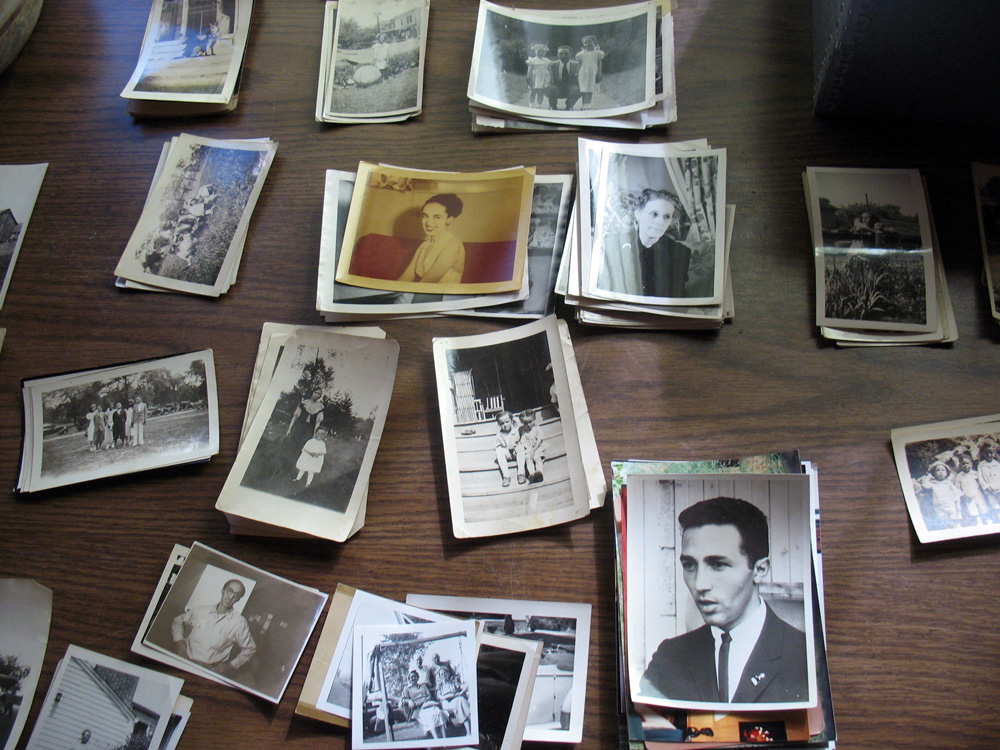 This week I spent hours putting my photographs from the paternal side in order. First by grouping them into piles according to the numbers on the reverse side. After dividing them up by number, I then started dating the files. I was able to determine who some of the babies were in later photos by which siblings were already there and how old they were. I will show some of these in a later post. It’s been slow going and I almost missed Sepia Saturday. However I thought I should make an entry. Above you see some of the piles.
This week I spent hours putting my photographs from the paternal side in order. First by grouping them into piles according to the numbers on the reverse side. After dividing them up by number, I then started dating the files. I was able to determine who some of the babies were in later photos by which siblings were already there and how old they were. I will show some of these in a later post. It’s been slow going and I almost missed Sepia Saturday. However I thought I should make an entry. Above you see some of the piles.
These two photographs have the same number. I have wondered for years if that boy with the stocking cap on standing next to the car was my father. When I saw the photo of my Uncle Louis (on the left) and my father, Albert, with the stocking cap, I saw it was him. There are other photos that have both boys that have different numbers but they appear to be taken at the same time on one of the family’s annual trips to Athens Tennessee, my grandfather’s hometown. One brother, Edward, remained in Athens. The rest of the family ended up first in Indianapolis, IN and then in Detroit, MI.
Here are some other posts about the Athens branch of the Cleages.
Uncle Ed’s daughters – 1917. Memories to Memoirs, and Juanita and Daughters.
To Read more Sepia Saturday post and to participate click HERE.
Today I spread all my Cleage photos out on the table and began putting them into order by number or date. While I was doing this, I found another photograph in the sequence that I posted about twice this week. Click here to see the photo of my grandparents, where I speculate that it was taken soon after their marriage. Several people wondered what he was holding over his shoulder. Click here to read about my discovery of the numbers on the back of most of the photographs.
I can see the people more clearly in this group photograph but, it is in bad shape. Starting from the left, are two headless women and I don’t know who they are. The little girl is my Aunt Barbara, next to her is my Uncle Hugh, Uncle Louis, Uncle Henry, Theodore Page (who looks like he has a double), a mystery girl, and the FLAG that my grandfather held over his shoulder. Behind them are, an unknown man, my great grandmother Celia Rice Cleage Sherman, her son Jacob, my father Albert “Toddy”, three people I don’t know then my grandfather Albert B. Cleage Sr. In the background are some other people. I don’t know who they are or where they are.
Click here to read other Sepia Saturday stories and to join in with a Sepia Saturday post of your own.
The Graham sisters were on my Finding Eliza blog, along with the next generation of Cleage sisters – my sister and me. Here are my aunts, the original Cleage sisters in the early 1940’s. Barbara, Gladys and Anna. For more Sepia Saturday posts click here.
 This photograph is dated September 1, 1919. The people from left to right are – my Grandfather Mershell C. Graham (aka Poppy), Mrs. Hicks from Chicago and Moses L. Walker. They seem to be having a picnic. I don’t know who Mrs. Hicks is. She only appears in the photos from this day. Uncle Moses wasn’t actually our uncle. He was the uncle of our cousins and an old friend of my grandparents from Montgomery, Alabama. My grandparents roomed with the Walkers when they first moved up to Detroit in 1918 and they were my Aunt Mary V.’s Godparents.
This photograph is dated September 1, 1919. The people from left to right are – my Grandfather Mershell C. Graham (aka Poppy), Mrs. Hicks from Chicago and Moses L. Walker. They seem to be having a picnic. I don’t know who Mrs. Hicks is. She only appears in the photos from this day. Uncle Moses wasn’t actually our uncle. He was the uncle of our cousins and an old friend of my grandparents from Montgomery, Alabama. My grandparents roomed with the Walkers when they first moved up to Detroit in 1918 and they were my Aunt Mary V.’s Godparents. I have transcribed below an interview my cousin Margret did with Uncle Moses daughter, Mignon.
Interview With Mignon Walker Brown
Margaret McCall Thomas Ward
Today is May 15, 1986. I am going to interview Mignon Walker Brown, my cousin, about her mother and her mother’s interest in cosmetics.
Margaret: You know, Victoria and I were over here one day about a month ago and in the conversation you described a recipe your mother used to make a face cream. Can you remember what it was she used to put in the face cream?
Mignon: Yes it was really not her recipe, it was her sister’s recipe who was a beautician in Chicago. She used lanolin, which was lamb fat. You bought the big pieces of lamb fat and you rendered them in the oven under a very slow fire (can’t understand several words) get too brown. You keep turning the fire off so it wouldn’t cook. And then when you had enough…there was a preparation called Palmer’s Skin Success. Now my aunt had a… the reason she used this in it, was she had a big beauty parlor down in the loop in Chicago…
Margaret: What was her name?
Mignon: and she had a rich Jewish cliental and they wanted their skin kind of bleached. Palmer’s Skin Success was a bleach. It was a green preparation came in a small jar that we bought, that my mother bought and you beat the lanolin with a rotary beater until it got very, very light and then you added this Palmer’s Skin Success, enough for whatever, you know, I don’t remember the proportion of that but enough to bleach as much as you wanted to. And then you added perfume to that. And that was the cream. And my mother used it and my aunt told her she was way ahead of her time because she used to go to Sweden every year to study and she used to make up her face to go to bed at night like you make it up in the daytime and this was before they had night creams and things. And she said that your face got as dirty at night, even though you were sleeping, as it did in the day, so that you should make it up to go to bed and then make it up again in the morning, which is the same principle as using night preparations. And that’s been… I was a little bitta girl then.
Margaret: And that would have been about 1920?
Mignon: Well, I was five or six and I was born in 1909. Couldn’t have been more then seven, so that would have been 1916.
Margaret: What was your mother’s maiden name?
Mignon: Owen. Jeannette Armor Owen.
(pause) It was in Chicago but I don’t remember the name of the shop.
Margaret: Did you ever visit your aunt in Chicago?
Mignon: Yes, they lived in Hyde Park. They lived as white all their lives. My mother didn’t like being white so she went back to live with her grandmother in Memphis, but Aunt Susie, there was a brother, Joe who was my mother’s half brother too, but they were siblings, full siblings, Aunt Susie and Uncle Joe lived with my grandmother in Hyde Park and Aunt Susie really made a lot of money. They never…
Margaret: What was her maiden… what was her name?
Mignon: Mausby M-a-u-s-b-y. And I didn’t know much about her father except that he ran what they called… I’m trying to think of what they … like Ferris wheels and that kind of thing. You know. What do they call those?
Margaret: Circus sideshows?
Mignon: They used to have them in neighborhoods even when we were children.
Margaret: um hum.
Mignon: And he ran those through the South. Evidently was very well off and my grandmother had divorced him and so my mother finished high school in Chicago before she went back, you know, to Memphis. The story behind that really was that my Grandmother was born about a year before Lincoln freed the slaves and she was the daughter of the plantation owner. My great-grandparents were slaves in Virginia.
Margaret: Where in Virginia?
Mignon: I don’t know where in Virginia. When the Civil War… when Lincoln freed the slaves, the man who owned the plantation called my great grandmother and her husband, her black husband, to the house and said, my great grandmother’s name was Sally, “Sally, you and Armor are free. You may do whatever you want. You may stay here and work on the plantation or you may leave but you are not taking Vicki with you because she is my child and I intend to keep her. So they left Virginia under the cover of night and took my grandmother and took her to Memphis.
She was well educated. They sent her to Oberlin to school and she taught school in Memphis and she married my mother’s father, whose name was Owen. And that’s all I know about him because he was dead when I was born.
Margaret: Who? Mr. Owen?
Mignon: Mr. Owen.
Margaret: You don’t know his first name?
Mignon: I don’t remember his first name.
Margaret: But he lived in Memphis?
Mignon: He lived in Memphis. She finally left. She, my grandmother taught school in Memphis. She finally married Mr. Mausby and moved to Chicago.
Margaret: And then by Mr. Mausby she had two children?
Mignon: She had more then two. The others died. Because I was named for one of those.
Margaret: I was going to ask you that. How did you get that beautiful name, Mignon?
Mignon: Well, she… my grandmother named one of her daughters Mignon and my mother named me that for her half sister who died when she was quite young.
Margaret: So now where did your mother and father meet?
Mignon: In Memphis.
Margaret: And how did that come about? Have you any idea?
Mignon: Yes. My father was from Montgomery but he went to Tuskegee to School. And he became a protégé of Dr. George Washington Carver and he wanted to go to business school so Dr. Carver made arrangements for him to get a job at Iowa State University to go to the business school for a year.
Margaret: George Washington Carver?
Mignon: George Washington Carver.
Margaret: Not Booker T. Washington?
Mignon: George Washington Carver.
Margaret: I never knew that.
Mignon: As a matter of fact, my father was very disappointed when I was born that I wasn’t a boy because I was to be named George Washington Carver. (Laughter.)
At any rate, Daddy went to Iowa and stayed the year. He did not graduate because he thought he had made an A in one course and they gave him a B and he would not accept the diploma. But he left there and his older sister lived in what was then Indian Territory before it became the State of Oklahoma.
Margaret: Which sister was that? Susan?
Mignon: His oldest sister Annie.
Margaret: Annie?
Mignon: Not Annie, Susie, his oldest sister Susie who was married and living there. And his occupation was to….he had a mule that he rode and sold Bibles to the Indians. And in his last illness we were sitting… there used to be a program on television (Oh dear my, cut it off I don’t want you to hear that.) He would look at this town and say “My goodness, the people who did these sets certainly knew what they were doing because it looked exactly like that town because he had traveled throughout the West.
He came back and went to Mississippi and worked for a man who had a grocery store. A general store, and he used to go to Memphis to buy for the store and in those days he had just come from the West and he wore his hair like Buffalo Bill, long and cut short and they used to tease my mother about her boyfriend with the curls. But anyway, this is how she met him because he went to Memphis to buy for the store.
Margaret: And what did she do? What was she doing then?
Mignon: My mother?
Margaret: Umm humm.
Mignon: Just living with my grandmother. She didn’t do anything.
Margaret: Where did she go to school?
Mignon: Chicago. She finished high school in Chicago.
Margaret: I see.
Mignon: And she became a milliner. Then she decided to go back to Memphis and she didn’t have to work.
Margaret: Now they married in Memphis?
Mignon: They married in Memphis and went to Washington to live. They married in 1908. At that time my father was working in the Treasury Department in Washington.
©Margaret McCall Thomas Ward May 2, 2003
End.
 My mother, Doris Graham Cleage at my Cleage grandparents house on Atkinson in Detroit, MI. I don’t know what the occasion was. My uncle Henry probably took the photo.
My mother, Doris Graham Cleage at my Cleage grandparents house on Atkinson in Detroit, MI. I don’t know what the occasion was. My uncle Henry probably took the photo.
For more Sepia Saturday offerings CLICK.

I’m in the front, my mother is propping up my sister Pearl. My father took the photo in our yard. He was the pastor of St. John’s Congregational Church in Springfield Massachusetts and we lived in the parsonage/community house right next to the church. We moved to my parents hometown, Detroit, when I was four where we still had plenty of snow.
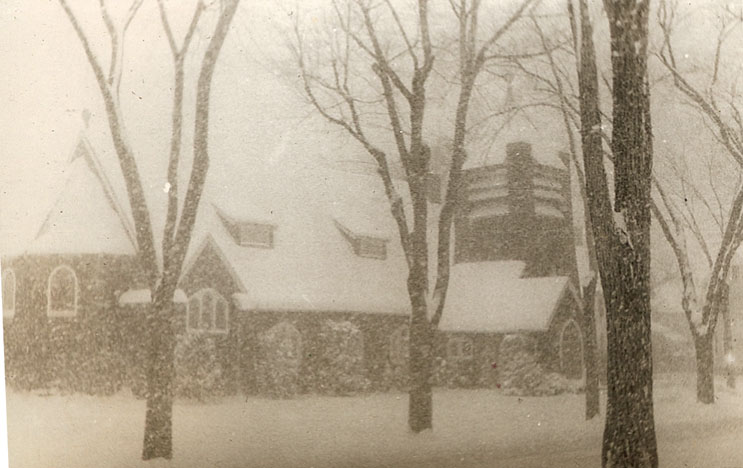
These photographs are in a crumpling album that my father put together back in the 1940’s. He wrote comments on all the photographs. I have to photograph or scan them before they disappear.
Click here to see more sepia saturday posts from around the world.

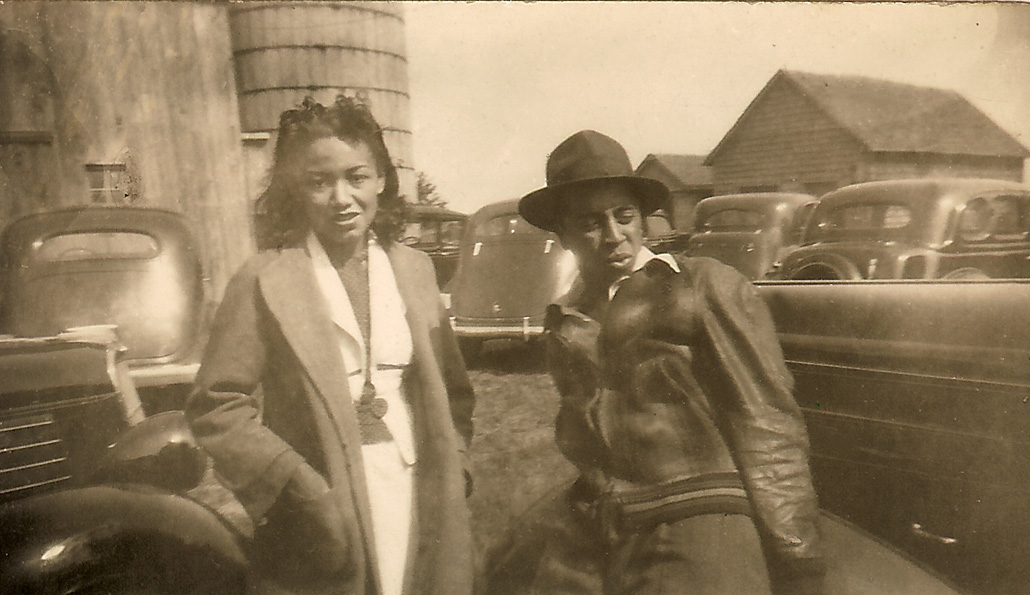
This photo is from a small black album I got from my uncle Henry. It had a lot of small photographs that look like they were cut from a contact sheet. They were pasted on themed pages, a page for my father, a page for each of his siblings, a page for several close family friends, etc. The pages and pictures aren’t labeled. I hope my aunts can shed some light on who the people in the picture are and if it was taken at the Meadows near Detroit. Judging by the ages of the people I know in the album I think the photos were taken in the early 1940’s.
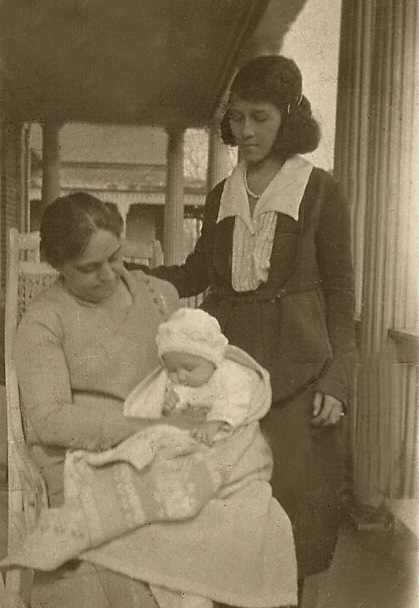
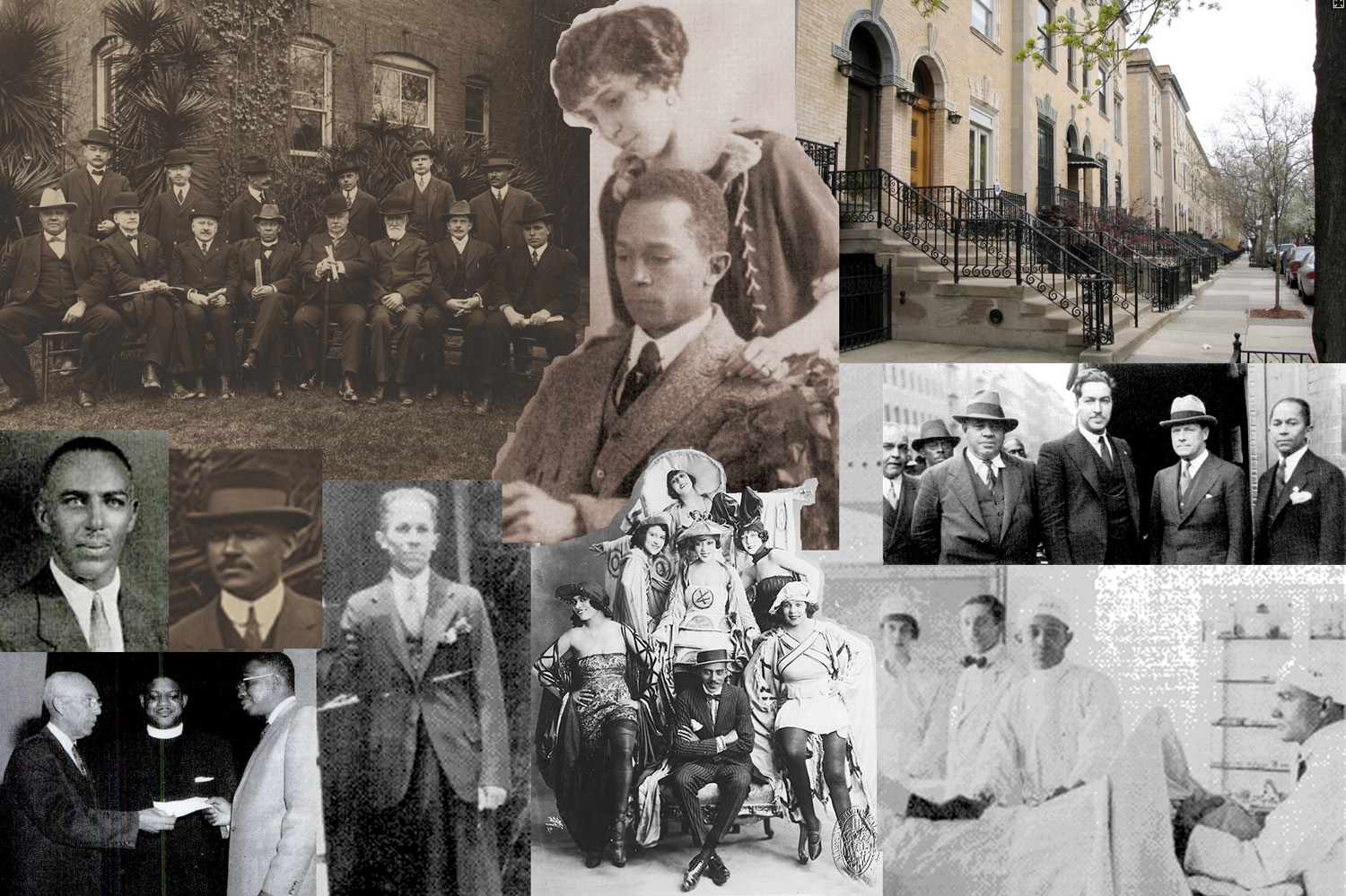
I worked all day yesterday pulling together records and information to write about why Aunt Willie might have been sitting so far from her husband, Uncle Victor, in my last weeks photo. I was going to use the photo on the left side which was taken on the same porch. I was going to talk about her relative’s memories of her as sad and obessesed with her daughter and her well being. About how her husband’s well known unfaithfulness, the death of two of her three children within three years of each other, the son her husband fathered earlier in the same year they were married and how the son, Victor Julius Tulane, and his mother lived right down the street from them in 1900.
Then I got interested in Victor Tulane’s early history, his mother who was a servant and probably former slave of Louis Tulane in Elmore County Alabama and his son, Horatio Tulane, who was twenty years her senior and Victor’s father. I was going to mention that the Tulane family recognized the relationship. How they were a merchant family and that after Victor packed his bags at age twleve and walked the 14 miles from Wetumpka to Montgomery, he became a very successful merchant too.
I was going to mention that Victor’s son, Victor Julius came to live with the family when he was in his teens and was sent to school in Michigan where he became a chemist. But at that point I decided to google Victor J. Tulane and see if I could find a picture of him because I did not have one. I like to have pictures. I had heard he looked very like Naomi, his half sister, but he had blue, blue eyes. I found two photographs of him, both from Crisis magazine. Then I thought I would look for his father. I found a group photograph with him in the Alabama Archives. I was on a roll, why not try to find a picture of Naomi’s husband, Ubert Conrad Vincent who was a well known black doctor in New York during the 1920’s. He pioneered a medical procedure that is known as the Vincent procedure. Here is where I hit the jackpot. I found an 8 page article from the Journal of the National Medical Association, 1975. That gave an in depth look at his whole medical career with 5 photographs, including one of him and his wife Naomi soon after their marriage. Naomi and Ubert’s daughter told me that they met at a cast party for the first black Broadway musical at the home of Noble Sissle so I looked for a cast photo. Found. Last, I looked for a photo of their residence on Striver’s Row in Harlem. Still there and lookin’ good.
Now I will identify the photographs in the collage above, starting from the bottom left.
Bottom row:
1. The Crisis Jun-Jul 1959. “First Church – Dr. Victor J Tulane (L), chairman of the trustee board of the John Wesley AME Zion church, Washington, D.C., presents chairman Theodore Taylor of the Washington branch a $100 check toward his church’s NAACP life memership. …”
2. “Dr. Vincent in the door of his Sanatorium”.
3. Noble Sissle with chorus girls from the musical “Shuffle Along”.
4. “Dr. Vincent (right at table) assisting Dr. Keyes (?) in an operation at Bellevue.” (Journal of the National Medical Association January 1975)
Middle row:
1. The Crisis Oct 1933 ” Awards To Dr. Victor J. Tulane of the University of Michigan, election to Sigma, Xi, honorary science fraternity. Mr. Tulane was awarded the degree of Doctor of Philosophy by the University of Michigan in June.”
2. A blow up of Victor Hugh Tulane’s head from the group photo above.
3. Skipping over to the group shot on the far right of that row – from the Journal – “Dr. Vincent (right) with (from left) Dr. Marshall Ross, Hon Adam Clayton Powell, Jr, and Mayor McKee.”
Top row:
1.Tuskegee College Board of Directors. Front row center is Booker T. Washington. Back row far right is Victor H. Tulane (Willie’s husband. Naomi’s father)
2. From the Journal “Dr. and Mrs. Vincent shortly after their marriage.”
3. From google street view, the place the Vincents called home.
My husband’s family is putting together an online family tree. Last week one of his sisters called to ask why their father’s half sister Catherine Williams wasn’t on it. I’ve been looking for Aunt Catherine for decades, starting when I asked my father-in-law what her mother’s name was. He told me he didn’t know because when her mother died and his father married his second wife, Catherine was raised by her grandmother and didn’t grow up with them.
I took this question as a challenge (of course) and started looking again. I have had good luck with Family Search Pilot and marriage records so I started by looking there for Arthur Williams in Dallas County, Arkansas. I knew that he was living in Dallas County in the 1900 and the 1910 from the censuses and that he was born about 1886. I found an Arthur Williams (b. 1887) and Nancy Burrough (b. 1890) were married in Dallas county 21 May 1908. I also found Arthur Williams married his second wife, Annie Willie Butler in Dallas County 11 Jan 1910.
Next I went to Ancestry.com and searched for Nancy Burrough in the 1900 census. She was living in Calhoun County, right below Dallas County, with James and Maggie Burrough, (her parents) and several siblings. She was 8 years old. I searched for Maggie Burrough and found her a widow in 1910. Living with her in Calhoun County were 5 children and one grandchild – 1 year old Carrie C. Williams. This seemed to be Catherine. I searched for Maggie in the 1920 census but didn’t find her or anyone else in the household. I had done wild card searches for Catherine before – Cathe*- because I thought she might spell it with an “i” or a “y”. Nothing. I tried a “K”. Still nothing. I tried the wild card with Cath* and there she was! In Calhoun County Cathrine Williams, now 11 years old, was living with her grandmother Maggie Burrow and her daughter Agnes M. Harrison her two children James E. Harrison and Oma Harrison, Maggie’s son Lindsy Burrow and two other grandchildren Roger L Walsh and Christine Vaughn.
We contacted Jim’s sisters with this information and received more information. Catherine had married a Mr. Hill. She died in Seattle, WA. I looked for her in both the Social Security Death Index and the Washington State Death index. I found that Catheryn Hill, last residence Seattle, born 27 Dec 1908 had died Jun 1979. Her social security card had been issued before 1951 in Missouri. The Washington Death Index told me Catherine N. Hill died 15 Jun 1979 in Seattle. She was 70 and born about 1909.
I passed this information along and suggested sending for death certificates and social security application and marriage license to document this information and make sure this was the right person. One of my sister-in-laws emailed back that she had an obituary for Catherine. I asked her to send me a copy, which she promptly did. Here is what it said.
“Catheryn Nancy Hill, born December 1907 in Thorton, Calhoun County, Arkansas, Departed this life Friday, June 15, 1979 in the Swedish Medical Center, Seattle, Washington.
She was reared by her grandmother, Mrs. Maggie Burrough, and Mr. and Mrs. Jesse McCoy of Thornton, Arkansas. At age 12 she united with the Mt. Zion Baptist Church. Served in choirs, Sunday School and other departments of the church. Reaching adulthood she moved to Little Rock, Arkansas and joined the Mt. Zion Baptist Church there under the Pastorate of the Rev. Fred T. Guy, Sr., later moving to St. Louis, Missouri.
In February the year of 1944, Mrs. Hill moved to Seattle, Washington and united with Mt. Zion Baptist Church by Letter from Union Baptist Church of St. Louis, Mo.
Mrs. Hill, a former Boeing employee was active in Civic, Health, Red Cross, Caring & Coping with young people, church and hospital work most of her life and found doing domestic and catering services an art in Arkansas cities of Hot Springs and Little Rock, St. Louis, Mo. and Seattle, Washington. “HELPING OTHERS” was her motto and source of survival.
Her memories will be cherished by Dad Jesse McCoy, Pine Bluff, Arkansas; brothers: Grover C. McCoy, Seattle, James E. Harrison and Chester A. Williams, St. Louis, Mo., Ambrose T. Williams, Greenville, Mississippi, James T. Williams, Chicago Illinois, Sterling B. Williams, Daphne, Alabama; Sisters: Mrs. Wylverlyn M. Williams, Chicago, Illinois, Mrs. Vinnie Jean Mitchell, Arkadelphia, Arkansas, Mrs. Verta Mae Wright, Wichita, Kansas; Cousins: Mrs. Ruth Johnson Jacobs, Thorton, Arkansas, Mrs. Corrine Fletcher and Mrs Lizzie Hurston, Detroit Michigan, Mr. Lenzie and Mr. James Burroughs, Los Angeles, California; a deceased brother; Rev. Samuel W. Williams M.A., D.D., PhD, was Dean of Religion at Morehouse College, Atlanta, Georgia.”
To read other Sepia Saturday offerings click link.